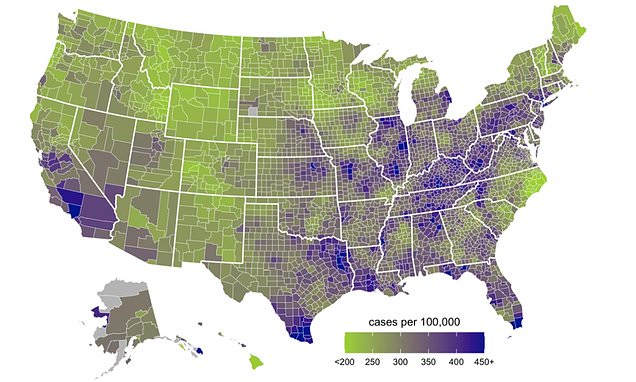In multiple pockets across the country, scientists are watching a disturbing trend emerge – Parkinson’s rates are soaring.
Experts suspect exposure to farming chemicals and factory fumes are to blame for the U-shaped portion of the US where rates of the debilitating disease are nearly 50 percent higher than national averages.
Southern California, the sunbelt and rustbelt states make up the region which experts are calling America’s ‘Parkinson’s Belt’.
Dr Tim Greenamyre, the director of the Pittsburgh Institute for Neurodegenerative diseases, had been conducting lab studies on one of the chemicals thought to be a factor – a pesticide known as Rotenone
A few years back he began noticing his left arm wasn’t swinging when he walked and he couldn’t smell.

It turns out Dr Greenamyre himself had developed the disease he was studying – which has no treatment and slowly erodes the control someone has over their body, eventually, leading to death.
The Pennsylvania doctor suspects he developed the disease because of the very chemicals he was studying in the lab, which could be one of the reasons rates are so high in his area.
‘My guess is that my laboratory work with making a model of Parkinson’s disease lead to my getting Parkinson’s disease’ Dr Greenamyre, told NBC News.
A 2022 study from researchers at the University of Pennsylvania identified Parkinson’s clusters in Southern California, Southeastern Texas, Florida and Central Pennsylvania. Most are in or near large industrial or agricultural operations, or both.

These clusters have led researchers like Dr Ray Dorsey, a neurologist at the University of Rochester, to conclude something in the environment must be raising local risk of Parkinson’s disease.
Dr Dorsey told NBC News: ‘If Parkinson’s disease was just due to chance, you wouldn’t expect to see parts of the country or parts of the world that have higher rates than other parts.’
His theory is that the chemicals released from historic factory and farm work have contributed to the Parkinson’s risk.
Pittsburgh used to produce half of the nations steel – and in the process, released plumes of chemicals onto surrounding dwellings. The problem was so severe that it was once known as ‘smoke city’.
Knowing this history, Dr Dorsey’s laboratory work focused on a chemical called trichloroethylene (TCE), a chemical which is used in dry cleaning, de-greasing and the manufacture of disinfectants, dyes, perfumes and soaps. The degreasing agents are often used in the steel making process.
The EPA clamped down on this chemical in 2023, proposing a ban on all uses of TCE, which they deemed ‘extremely toxic’. It has been linked to cancer, nerve damage and reproductive problems.
In a 2023 study, Dr Dorsey said that studies have also linked the chemical to a 500 percent increased risk of developing Parkinson’s.
They are unsure how the chemical might do this, but suggest that it could change the way that brain cells use energy, the study said.
Other labs, like Dr Greenamyre’s, are looking to agriculture, not industry, to see if it has a link to the neurodegenerative disease.
Rotenone, is a chemical used across the country as a pesticide on crops and live stock and to manage fish populations, as well as by home gardeners.
Parts of the Parkinson’s belt are in highlight agricultural areas, like Kern county in California, which produced almonds, grapes and citrus fruits, that might’ve used this pesticide previously or currently.
Beginning in the 1990’s, Dr Greenmyre began to see investigating this chemical. In 2011, a study found that farmers who used rotenone had a 2.5 times higher risk of developing Parkinson’s disease than those who didn’t.
In 2000, Dr Greenmyre and his team published a study in Nature that showed how injecting rotenone into rats caused them to develop problems moving within three months.
At nine months, the chemical had caused changes in their brains that was similar to what you’d see in a human Parkinson’s patient.
Sometimes, in studying the chemical, it would get on his gloves, Dr Greenmyre recalled in the journal Science in 2023. This exposure would come back to him when he was diagnosed with Parkinson’s in 2021, suspecting a link to his research.
‘The irony is obvious,’ Dr Greenmyre said.
In response, the EPA restricted the use of rotenone twice, and it’s no longer available for purchase by home gardeners. Still, with some red tape, it is available for use, and the EPA said there is ‘insufficient evidence’ to link the chemical to Parkinson’s.
About 1million people in the US are currently living with the condition- the Parkinson’s Foundation estimates that number will rise to 1.2million by 2030.


This is because in general, life expectancies have increased across the world – meaning there are more elderly people, and more people overall being diagnosed with all kinds of neurodegenerative diseases – from Parkinson’s to Alzheimer’s.
Some estimates suggest that with 90,000 new patients being diagnosed each year, Parkinson’s is the fastest growing degenerative disease.
Parkinson’s disease is a condition that attacks the nervous system – causing the break down of cells that are responsible for controlling movement. Both world-famous boxer Muhammad Ali and actor Michael J Fox were diagnosed with the disease.
Early symptoms might include tremor, slowed movement, rigid muscles and speech and writing changes. Over time, these symptoms get worse, affecting every muscle in the body, often leaving someone wheel-chair bound.
Though the disease itself doesn’t usually kill, it causes complications that do, like increasing fall risk or likelihood of developing pneumonia.
Doctor’s don’t know what causes the disease – it’s thought that genetics could be responsible for about 15 percent of the cases.
The clusters seen across the United States add credence to the theory that 85 percent of cases are linked to another factor, like the environment.
Because researchers have yet to figure out the cause behind the disease, there are also few treatment options available.
The standard course of treatment, involves taking two pills, Carbidopa and levodopa, has been the standard for decades. It doesn’t stop the progression of the disease, but can help people manage their symptoms early on.



